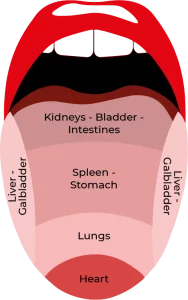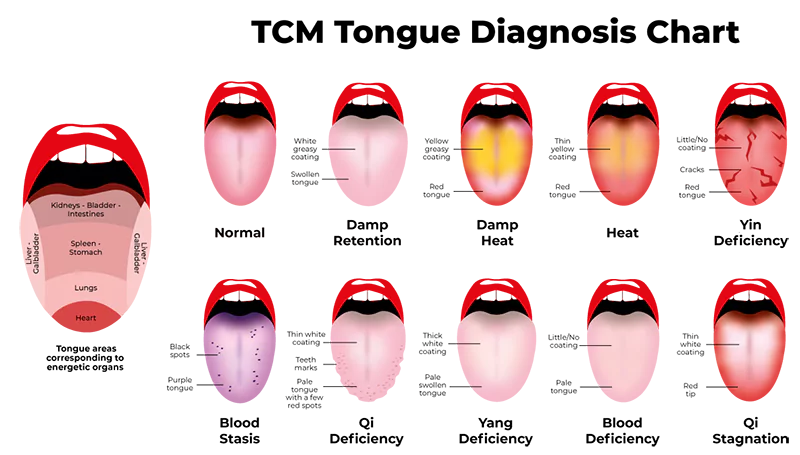The tongue diagnosis chart is an ancient practice deeply rooted in Traditional Chinese Medicine that helps identify pathology and symptoms in a patient’s teeth. It serves as a valuable tool for oriental medicine practitioners during patient consultation, offering insights into the nature of an individual’s overall health and well-being, including any potential pathology.
By examining the color, texture, coating, and shape of the tongue, practitioners can gather important diagnostic information about body color and pathology without invasive procedures or costly tests. This consultation tool is valuable for understanding the overall health of a patient.
This non-invasive and cost-effective method, used by an oriental medicine practitioner, allows for a holistic assessment of a patient’s various bodily systems through pulse diagnosis. It can help identify underlying imbalances or potential health issues related to the patient’s nature.
- Basics of Tongue Diagnosis in Traditional Chinese Medicine
- Importance of Tongue Examination for Accurate Diagnosis
- Understanding the Tongue Map: Insights into Health and Wellness
- Decoding Tongue Color: Indications and Meanings
- Analyzing Tongue Shape for Health Assessment
- Exploring Cracked or Fissured Tongue: Syndromes and Implications
- Chinese Tongue Diagnosis Charts and Posters: A Comprehensive Visual Guide
- Harnessing the Power of Tongue Diagnosis Charts
Basics of Tongue Diagnosis in Traditional Chinese Medicine
Examining the Tongue’s Clues
In Traditional Chinese Medicine (TCM), tongue diagnosis is an essential practice for practitioners. It involves observing the color, shape, coating, and moisture of the tongue to understand the nature of a person’s pulse. By examining the pulse, tongue shape, and rate, practitioners of oriental medicine can gain valuable insights into the state of internal organs and energy flow within the body.
Understanding Internal Balance
The tongue serves as a mirror to our overall health, providing valuable insights to an oriental medicine practitioner. By examining the tongue’s color, texture, and moisture level, the practitioner can assess the pulse rate and identify any imbalances in the body.
In Traditional Chinese Medicine (TCM), different areas of the tongue correspond to specific organs and meridians. This information is essential for an oriental medicine practitioner to assess a patient’s health.
By observing the tongue, the practitioner can gather valuable insights into the patient’s overall well-being. Along with other diagnostic tools like pulse analysis, the tongue examination plays a crucial role in TCM diagnosis.
or example, the shape of the tongue reflects the heart’s health, while the pulse felt on the sides of the tongue relates to the liver and gallbladder. By carefully analyzing the pulse and tongue shape, along with other characteristics, practitioners can identify imbalances or potential health issues.
Colorful Clues
The color of the tongue, along with the pulse, provides significant information about a person’s well-being. A pale or white tongue may indicate a deficiency in qi or blood circulation, while a red or purple hue might suggest heat or stagnation in the pulse. A bluish tint in the skin could indicate coldness or poor oxygenation, potentially affecting the pulse.
Shape Matters Too
The shape of the tongue, along with the pulse, also holds important clues regarding one’s health. A swollen or puffy tongue might signify fluid retention or dampness in the body, affecting the pulse. On the other hand, a thin and pointed tongue could be indicative of yin deficiency, which can also be assessed by checking the pulse.
Coating and Moisture Insights
The coating on the surface of the tongue reveals further details about one’s condition, including their pulse. A thick coating on the tongue may indicate an excess of pathogenic factors such as heat or dampness, while a thin coating might suggest deficiency patterns. When examining a patient, it is important to consider their pulse as well. Dryness or excessive moisture on the tongue can provide additional insights into imbalances within the body’s pulse.
By combining all these observations together, TCM practitioners can develop a comprehensive understanding of their patient’s health conditions and tailor treatment plans accordingly. The pulse is one of the key indicators that TCM practitioners use to assess their patients’ health.
Importance of Tongue Examination for Accurate Diagnosis
In Traditional Chinese Medicine (TCM), tongue examination, along with pulse assessment, plays a crucial role in enhancing diagnostic accuracy. By carefully observing the color, shape, coating, and other characteristics of the tongue, practitioners can gather valuable information about a patient’s overall health and identify underlying imbalances or conditions.
Enhances diagnostic accuracy in Traditional Chinese Medicine
Tongue diagnosis is considered one of the primary methods used in TCM to assess a person’s health. It provides valuable insights into the functioning of different organs and systems within the body. By analyzing the various aspects of the tongue, such as its color, coating, moisture level, and shape, practitioners can identify patterns that indicate specific imbalances or disharmonies.
Complements other diagnostic methods like pulse diagnosis
While pulse diagnosis is another essential diagnostic technique in TCM, tongue examination complements it perfectly. The combination of both methods allows practitioners to obtain a more comprehensive understanding of a patient’s condition. While pulse diagnosis provides information about the state of Qi (energy) and blood circulation in the body, tongue examination offers insights into organ function and overall health.
Enables personalized treatment plans based on individual conditions
By incorporating tongue examination into their diagnostic process, TCM practitioners can develop personalized treatment plans tailored to each individual’s unique needs. The findings from tongue diagnosis help determine which acupuncture points should be targeted during treatment sessions and which herbal remedies may be most effective for restoring balance.
Understanding the Tongue Map: Insights into Health and Wellness
Different Areas of the Tongue Correspond to Specific Organs or Body Systems

The tongue is not just a taste bud powerhouse; it also serves as a valuable source of information about our health. Different regions of the tongue are believed to correspond to specific organs or body systems. For example, the tip of the tongue is associated with the heart and lungs, while the middle section represents the digestive system. The back of the tongue is thought to reflect the state of our kidneys and bladder.
Changes in Different Regions Indicate Imbalances or Disorders in Corresponding Areas
By closely examining these different areas, practitioners can gain insights into a person’s overall health. Any changes observed on specific parts of the tongue can indicate imbalances or disorders in corresponding areas of the body. For instance, if there are unusual markings or discoloration on the back of someone’s tongue, it could be an indication of kidney or bladder issues. Similarly, changes in texture or coating on other parts may suggest problems with digestion or respiratory function.
Offers a Holistic View of One’s Health Status
A tongue diagnosis chart provides a holistic view of one’s health status by considering various aspects such as color, shape, texture, moisture level, and coating presence in different regions. It helps identify potential imbalances and enables practitioners to tailor treatment plans accordingly. By analyzing these visual cues along with other diagnostic methods, healthcare professionals can gather valuable information about a person’s well-being.
Understanding how different regions of our tongues relate to various organs and body systems can offer essential clues about our overall health condition. Regularly checking your own tongue using a tongue diagnosis chart can help you become more aware of any changes that may warrant further investigation from a healthcare provider.
Decoding Tongue Color: Indications and Meanings
Pale Tongue: Blood Deficiency or Anemia
A pale tongue may indicate that there is a lack of blood or anemia in the body. This can be a sign of nutrient deficiency or poor absorption of nutrients. It’s important to ensure a balanced diet with enough iron, vitamin B12, and folic acid to support healthy blood production.
Red Tongue: Heat or Inflammation
If your tongue appears red, it could be a sign of heat or inflammation within the body. This might be due to an infection, fever, or excessive internal heat. It’s essential to identify the underlying cause and take appropriate measures to address it. Drinking plenty of water and consuming cooling foods like cucumber and watermelon can help alleviate the heat.
Purple or Bluish Tint: Poor Circulation or Stagnation
A purple or bluish tint on the tongue may indicate poor circulation or stagnation in the body. This could be related to issues such as cardiovascular problems, poor oxygenation, or sluggish metabolism. Regular exercise, maintaining a healthy weight, and incorporating circulation-boosting foods like ginger into your diet can help improve blood flow.
Understanding these indications through tongue color can provide valuable insights into your overall health. However, it’s important to remember that tongue diagnosis is just one aspect of assessing well-being and should not replace professional medical advice.
Analyzing Tongue Shape for Health Assessment
The shape of your tongue can provide valuable insights into your overall health. By examining its appearance, you can gain clues about various aspects of your well-being, such as fluid retention, digestive issues, deficiencies, and organ weaknesses.
Swollen Tongue: Fluid Retention or Digestive Issues
If you notice that your tongue appears swollen or puffy, it may be an indication of fluid retention or underlying digestive problems. This could be due to excessive sodium intake, hormonal imbalances, allergic reactions, or certain medical conditions. Consulting with a healthcare professional is recommended if you experience persistent swelling.
Thin and Pointed Tongue: Deficiency in Body Fluids or Yin Energy
A thin and pointed tongue may suggest a deficiency in body fluids or yin energy. Yin energy represents the cooling and nourishing aspects of our body. When this energy is lacking, it can lead to dryness and imbalance. Adequate hydration and nourishment are essential to restore balance in such cases.
Scalloped Edge: Spleen Weakness or Excessive Dampness
If the edges of your tongue appear scalloped or indented, it could indicate spleen weakness or excessive dampness within the body. The spleen plays a crucial role in digestion and immune function. Weakness in this organ can lead to issues such as poor digestion and nutrient absorption. Addressing any underlying causes and adopting a healthy lifestyle can help improve spleen function.
By paying attention to the shape of your tongue along with other factors like color, coating, quality of teeth marks on its sides (if present), overall condition, pulse rate (as assessed by a healthcare professional), you can gather valuable information about your health status.
Exploring Cracked or Fissured Tongue: Syndromes and Implications
Cracks or fissures on the tongue can reveal valuable information about a person’s health. Let’s delve into the various syndromes and implications associated with a cracked or fissured tongue.
Dryness, Dehydration, and Aging
Deep cracks on the tongue may be indicative of dryness, dehydration, or even aging. When the body lacks sufficient fluids, it can result in a parched mouth and subsequently lead to deep cracks on the surface of the tongue. This condition is often seen in individuals who don’t consume enough water or suffer from certain medical conditions that cause excessive fluid loss.
Digestive Disorders: Irritable Bowel Syndrome
Horizontal fissures found on the tongue could potentially signify digestive disorders like irritable bowel syndrome (IBS). IBS is characterized by irregular bowel movements, abdominal pain, and discomfort. The presence of these horizontal cracks might indicate an underlying imbalance in the digestive system. It is crucial for individuals experiencing such symptoms to consult a healthcare professional for further evaluation and guidance.
Kidney Imbalance: Vertical Cracks
Vertical cracks running along the length of the tongue might suggest an underlying kidney imbalance. The kidneys play a vital role in filtering waste products from our blood and maintaining fluid balance in the body. Any disruption in kidney function can manifest as vertical cracks on the tongue’s surface. If you notice these vertical fissures, it is advisable to seek medical advice to determine if there are any underlying kidney issues that need attention.
By examining your tongue regularly, you can gain insights into your overall well-being. However, it’s important to remember that while these findings can provide valuable clues about your health status, they should not be used as standalone diagnostic tools. Consulting with a healthcare professional is essential for accurate diagnosis and appropriate treatment.
Tongue Color | Possible Implications |
Pale | Blood deficiency or anemia, nutrient deficiency, poor absorption of nutrients |
Red | Heat or inflammation, infection, fever, excessive internal heat |
Purple/Bluish | Poor circulation or stagnation, cardiovascular problems, poor oxygenation, sluggish metabolism |
Swollen | Fluid retention, digestive issues, excessive sodium intake, hormonal imbalances |
Thin/Pointed | Deficiency in body fluids or yin energy, dryness, imbalance |
Scalloped | Spleen weakness, excessive dampness, poor digestion, nutrient absorption |
Cracked | Dryness, dehydration, aging, digestive disorders (e.g., IBS), kidney imbalance |
Chinese Tongue Diagnosis Charts and Posters: A Comprehensive Visual Guide
Chinese tongue diagnosis charts and posters are valuable visual aids that provide a comprehensive guide to understanding different aspects of tongue diagnosis. These illustrations offer detailed depictions, making it easy for practitioners and patients to reference and compare various tongue characteristics.

Visual Reference for Tongue Diagnosis
Tongue diagnosis is an essential component of Traditional Chinese Medicine (TCM) that helps assess the overall health and balance of the body’s qi, or vital energy. By observing the color, shape, coating, and other features of the tongue, TCM practitioners can gain valuable insights into a person’s health condition.
Detailed Illustrations for Easy Comparison
Chinese tongue diagnosis charts and posters feature detailed illustrations that showcase a wide range of tongue characteristics. These visuals help practitioners identify patterns and abnormalities in the tongue’s appearance more easily. With clear depictions of different colors, shapes, coatings, cracks, and other indicators on the tongues, these resources serve as handy references during consultations.
Understanding the Significance of Tongue Characteristics
The purpose of these charts and posters is to aid in understanding the significance of various tongue characteristics. Each characteristic represents different imbalances or conditions within the body according to TCM principles. By using these visual guides, both practitioners and patients can learn how specific features correspond to certain organ systems or meridians in TCM theory.
Using Chinese tongue diagnosis charts and posters can enhance communication between practitioners and patients by providing a common visual language when discussing health concerns. Patients can also gain a better understanding of their own health status by comparing their tongues with those depicted on the charts.
Harnessing the Power of Tongue Diagnosis Charts
We have delved into the fascinating world of the tongue map, providing insights into how different areas of the tongue can reflect our overall health and wellness. Furthermore, we have discussed the significance of tongue color and shape in assessing our well-being.
By understanding these various aspects of tongue diagnosis, we can gain valuable insights into our health conditions and potential imbalances within our bodies. Tongue diagnosis charts serve as comprehensive visual guides that aid practitioners and individuals alike in interpreting their findings accurately.
To further enhance your understanding and application of tongue diagnosis, it is recommended to explore additional resources such as books, online courses, or consultations with qualified practitioners. By harnessing the power of tongue diagnosis charts and deepening your knowledge in this field, you can take a proactive approach to your health and well-being.
FAQs
What are some common indicators found on a tongue diagnosis chart?
Tongue diagnosis charts often depict indicators such as coating thickness, color variations, cracks or fissures, shape abnormalities, and other characteristics. These indicators provide valuable information about an individual’s internal organ function, energy flow, nutrient deficiencies, or potential pathogenic factors.
Can I self-diagnose using a tongue diagnosis chart?
While a tongue diagnosis chart can provide useful insights into your health condition, it is important to note that self-diagnosis should not replace professional medical advice. A trained practitioner who specializes in Traditional Chinese Medicine will consider multiple factors beyond just visual observations to make an accurate assessment.
How do I find a qualified practitioner who uses tongue diagnosis?
To find a qualified practitioner who utilizes tongue diagnosis techniques in their practice, it is advisable to seek recommendations from trusted sources such as friends or family members who have had positive experiences with TCM practitioners. Professional associations or directories of Traditional Chinese Medicine practitioners can provide a list of qualified individuals in your area.
Are tongue diagnosis charts used only in Traditional Chinese Medicine?
While tongue diagnosis charts are commonly associated with Traditional Chinese Medicine, they can also be utilized by practitioners of other holistic health systems that emphasize the connection between the tongue and overall health. These include Ayurvedic medicine and some naturopathic approaches.
How often should I examine my tongue using a chart?
Regularly examining your tongue using a chart can help you monitor any changes or patterns over time. However, it is important to remember that tongue appearance can vary throughout the day due to factors such as food consumption or temporary imbalances. If you have specific health concerns, it is advisable to consult with a qualified healthcare professional for personalized guidance.



